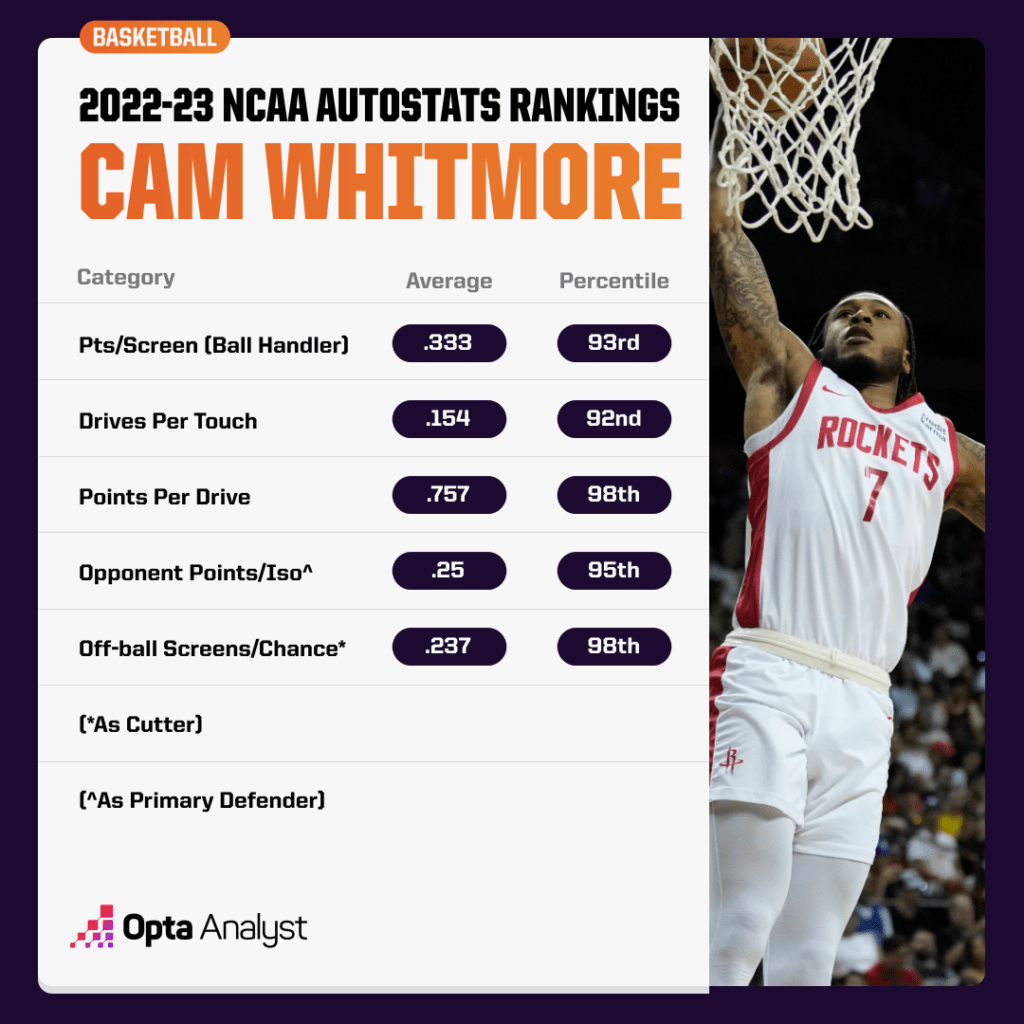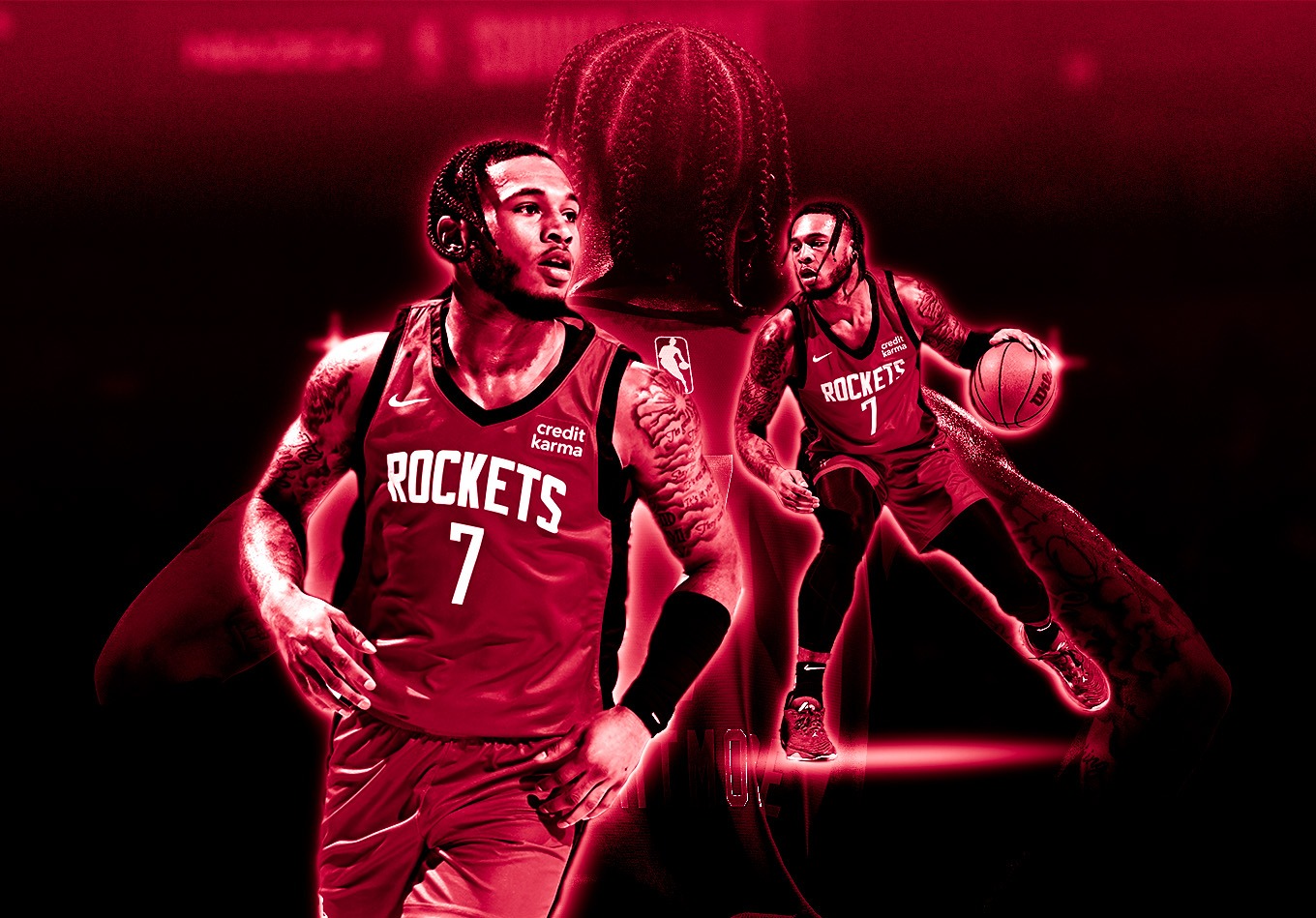Despite being rumored as a potential top-five selection, Cam Whitmore made a painful slide down to 20th in last month’s NBA Draft. At that point, the Houston Rockets, making their second pick of the night, were happy to nab the locomotive, 6-foot-7 wing.
During his introduction to the NBA this July, Whitmore left quite the first impression, averaging 19.3 points (52.7% true shooting), 5.2 rebounds, 2.5 steals and 2.0 assists per game. He helped lead the Rockets to a 5-1 record and earned 2023 Summer League MVP.
Whitmore’s Summer League MVP contemporaries stretch back to 2006 and have encouraging predictive power for becoming, at a minimum, a viable rotation player. Among the 17 other winners, only two, Josh Selby (2012) and Glen Rice Jr. (2014), failed to latch on somewhere as long-term NBA dudes. The future for Cam Thomas (2021) remains hazy, but it’s early and he’s shown promising flashes. Everyone else has endeared themselves to the league.
The list is littered with high-level role players and starters, including Josh Hart (2018), Jonas Valanciunas (2013), Kyle Anderson (2015) and Tyus Jones (2016), and peaks with superstars such as Damian Lillard (2012) and Blake Griffin (2009).
Some of Whitmore’s peers required time to nail down their NBA footing, so he might not immediately solidify himself next season, especially on a Houston squad loaded with intriguing youngsters and win-now veterans. Regardless, though, he and his supporters should feel good about what that broad indicator of a Summer League MVP moniker suggests for his NBA voyage.
So, as he prepares for his first season and the prestige of his honor shifts toward a focus on the next step, how should we parse through and interpret his performance? Where did he shine? Where did he leave room to grow along his path to joining the ranks of Summer League MVPs who carved or are still carving out prosperous careers?
Dating back to before the draft, much of his allure stemmed from his potential as a ferocious, intrepid slasher. According to AutoStats tracking data, he generated .757 points per drive (98th percentile) last season at Villanova.

A 6-foot-7, 235-pound wing, Whitmore is explosive, powerful and unburdened by contact. He plays through and seeks it, regularly chiseling through point-of-attack defenders or imminent help inside the paint.
His blend of strength and speed for a 19-year-old player is remarkable, and he displayed the merits of those qualities using body feints, subtle footwork or deceptive glances to forge openings with or without screens. Once he shifted defenders off-kilter and committed downhill, their chances of recovering were minimal.
The change of pace is like an avalanche.
Yet Whitmore does not always commit downhill, nor is he equipped to beam his way toward the rim whenever he wishes. These limitations are a product of both cumbersome shot selection and a tenuous handle. Forty-nine of his 103 shot attempts in six Summer League games came beyond the arc – and he knocked down 14 of them (28.6%). He shot 34.3% on 108 3s in his one and only season at Villanova.
Armed with an elevated release and shifty space creation, he can fire long balls on a whim and did so throughout Summer League, many of which were arduous or contested. Sometimes, he dazzled with mesmerizing, star-type shot-making, so the long-term appeal if consistency emerges is evident. But he left a lot on the table with his decision-making, given the level of outside shooter he seems to be at the moment.
Despite his frame, burst and physicality – illuminated by his 59.3% clip (32 of 54) inside the arc – he only yielded a .155 free-throw rate (16 free throws) and 52.7% true shooting, the combination of some iffy whistles and his tendency to dance around the perimeter like this:
Not all of these outcomes are tied to Whitmore’s individual approach, though. His handle is quite restrictive and impacts how often he can leverage his 0-60 burst as an interior explorer. Ball pressure bothers him. Get into his body on drives and he might be stuck.
This current shortcoming hindered him about as much as his long-range fixation. He struggles to sync dexterous ball handling with his explosiveness and that complicates his creation trials.
The good news is he will not be tasked with anywhere close to as many on-ball responsibilities as he was during Summer League, particularly once Amen Thompson, Jabari Smith Jr. and Tari Eason exited the lineup. At least initially, on-ball refinement will presumably occur whenever, if ever, Whitmore sees time in the G League. With the Rockets, he should be enabled to thrive as an off-ball scorer in the ways he experienced the most success in Las Vegas and displayed how he can fit with the rest of their regular season roster and young core.
Whitmore is a marvelous cutter all over the floor. Whether defenders overplay a screen/handoff or simply lose sight of him, he recognizes when to pounce on opportunities. He’ll set up back cuts against top-locking schemes and can whip to the rim to fashion clear separation, which he did numerous times inside Thomas & Mack Center.
He’s a dynamite leaper off two feet and exploits openings to help produce ideal offensive possessions. I expect him to connect with Thompson and Alperen Sengun quite a bit over the next few seasons as that duo commandeers playmaking duties and he flows around them.
Cutting is a pretty fickle and narrow avenue through which to score, though, so the majority of Whitmore’s reps should come as a second-side creator pressing through seams and attacking off the catch. He has a tendency to proceed slowly, reset and devolve advantages into daunting pull-ups. That’s an area to iron out.
When he acted decisively and had space to maneuver, however, the intrigue popped; the opposition was stuck in another dimension. He discarded defenders with the ease of taking off a jacket and placing it on a coat rack. A timeline in which Thompson, Sengun and Jalen Green are piloting the offense, while Whitmore is feasting on their creation, crystallizes when he authors clips like these:
As Summer League wore on, he increasingly busted out hop steps to neutralize stunts targeting his shaky handle. His savvy priming screens translates here. He can overwhelm ill-suited rim protectors with his physicality, size and two-foot leaping. However, I did notice discomfort or aversion to extending off one foot and a propensity to reach a full jump stop before elevating, which hampered some of his finishing. That might’ve been a small sample outlier for me, but it reared its head on numerous occasions.
I’d love for the Rockets to run tons of “Chicago” plays that can audible into empty corner ball screens – giving him space to avoid any potential handling pitfalls – as well as other DHO sets. He and Sengun could become a fortuitous partnership. Iverson cuts, Veer actions and Delay sets are also practical, the last of which new head coach Ime Udoka ran regularly for Jayson Tatum and Jaylen Brown two seasons ago. Swapping Sengun in place of Al Horford or Robert Williams III as the triggerman is a fairly seamless adaptation.
I see plenty of parallels between Whitmore and Brown: a rigid handle, questions as a primary initiator, inconsistent playmaking vision, ethereal 0-60 explosiveness, fearlessness and functional size as a finisher, adeptness flowing through staggered pindowns, and comfort hoisting contested 3s. Granted, Brown is a much more accomplished shooter than Whitmore right now, but he once was not. Udoka and assistant Ben Sullivan coached Brown for a year. That may bode well for Whitmore’s deployment. The blueprint for how to amplify and insulate his skill set exists.
As hulking and gifted an athlete as Whitmore is at his size, I wonder what the possibilities are of some atypical big-man usage for him. Could he be a reliable roller or low-block mismatch scorer? Those are two avenues that may remove the siren song of deep, audacious pull-ups, mitigate his loose handle and put him in advantageous spots near the hoop (where he excels). He should be living in the paint and at the charity stripe, while using the threat of his jumper as a complementary tool, not treating it as the basis of his scoring. These play types can help enact such an integral shift.
His Summer League tape does not imply imminent stardom. But the reasons for abundant optimism circulate, perhaps occasionally nestled among some wide-eyed jumpers, missed passing windows and tottering dribble sequences. They nonetheless exist.
Patience is mandatory as Whitmore, who turned 19 only 12 days ago, discovers his optimal self, how that differs from his current playstyle, and everything he must accomplish to bridge the gap between those endpoints. If he rewards that patience, he and the Rockets will be rather content.
It just might take some time.
Like this? Follow us on Twitter for more.
